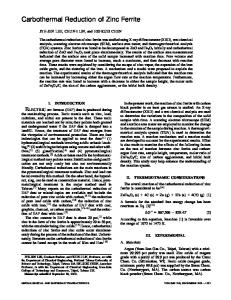Fabrication of molybdenum carbide catalysts over multi-walled carbon nanotubes by carbothermal hydrogen reduction
- PDF / 630,625 Bytes
- 7 Pages / 593.972 x 792 pts Page_size
- 101 Downloads / 331 Views
Catalysis Letters, Vol. 116, Nos. 1–2, July 2007 (Ó 2007) DOI: 10.1007/s10562-007-9093-x
Fabrication of molybdenum carbide catalysts over multi-walled carbon nanotubes by carbothermal hydrogen reduction Xiaoyun Li, Ding Ma, Limin Chen, and Xinhe Bao* State Key Laboratory of Catalysis, Dalian Institute of Chemical Physics, Chinese Academy of Sciences, 457 Zhongshan Road, P.O. Box 110, Dalian 116023, P.R. China
Received 18 March 2007; accepted 18 March 2007
Molybdenum carbide catalysts were successfully prepared using original multi-walled carbon nanotubes (MWCNTs) and nitric acid treated ones as support and carbon source by carbothermal hydrogen reduction from 580 °C to 700 °C. Ammonium heptamolybdate was used as Mo precursor and the effects of oxygen functional groups on MWCNT surface were investigated. TEM and XRD results show that oxygen functional groups act as anchor sites to interact with the Mo oxyanion species during impregnation, which promote the dispersion of Mo precursors. Due to the relatively strong interaction between Mo precursors and MWCNTs, the agglomeration of Mo carbide particles is prevented even when the treatment temperature is as high as 700 °C. Moreover, as the support, modified MWCNTs exhibit better thermal resistances. The temperature (580 °C) for Mo2C formation over MWCNTs is much lower than that over conventional carbon supports using carbothermal hydrogen reduction. The methylcyclohexane dehydrogenation was used as a probe reaction to test the catalytic performances of the Mo2C catalysts obtained. KEY WORDS: molybdenum carbide; carbon nanotubes; surface oxygen groups; molybdenum oxyanion; methylcyclohexane dehydrogenation.
1. Introduction Mo2C catalysts have received considerable attention since they show catalytic properties comparable to the noble metals [1–3]. In particular, Mo2C catalysts are very efficient in some hydrogen-involved reactions, very much similar to Pt, Ir and Rh catalysts [4–12]. However, as native Mo2C has very small surface areas, to prepare Mo2C with high surface areas or to make it highly dispersed over support is critical to apply this material into the practice. Normally, some materials with high surface areas such as alumina, zeolite and carbon are used as supports to prepare supported molybdenum carbide catalysts [13–15]. The supported Mo2C catalysts often exhibit much more active and stable [13,14] than bulk Mo2C catalysts. When oxides are used as supports for molybdenum carbide catalysts, alkane or alkene precursors are usually needed as carbon source in the preparation process. On the other hand, carbon materials are promising supports in many Mo2C-related catalyst systems. Beside the role of support, carbon materials are also able to provide the carbon source for the carbide. Thus the unnecessary carbonaceous depositions are avoided on the surface. Ledoux and Pham-Huu synthesized metallic carbides using the reaction of the vapor of metal oxide *To whom correspondence should be addressed. E-mail: [email protected]
with the solid carbon at very high temper
Data Loading...











